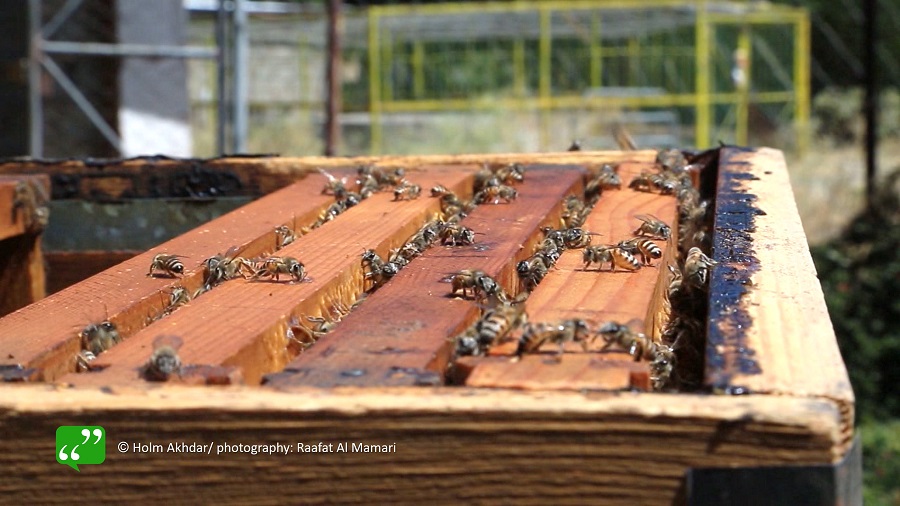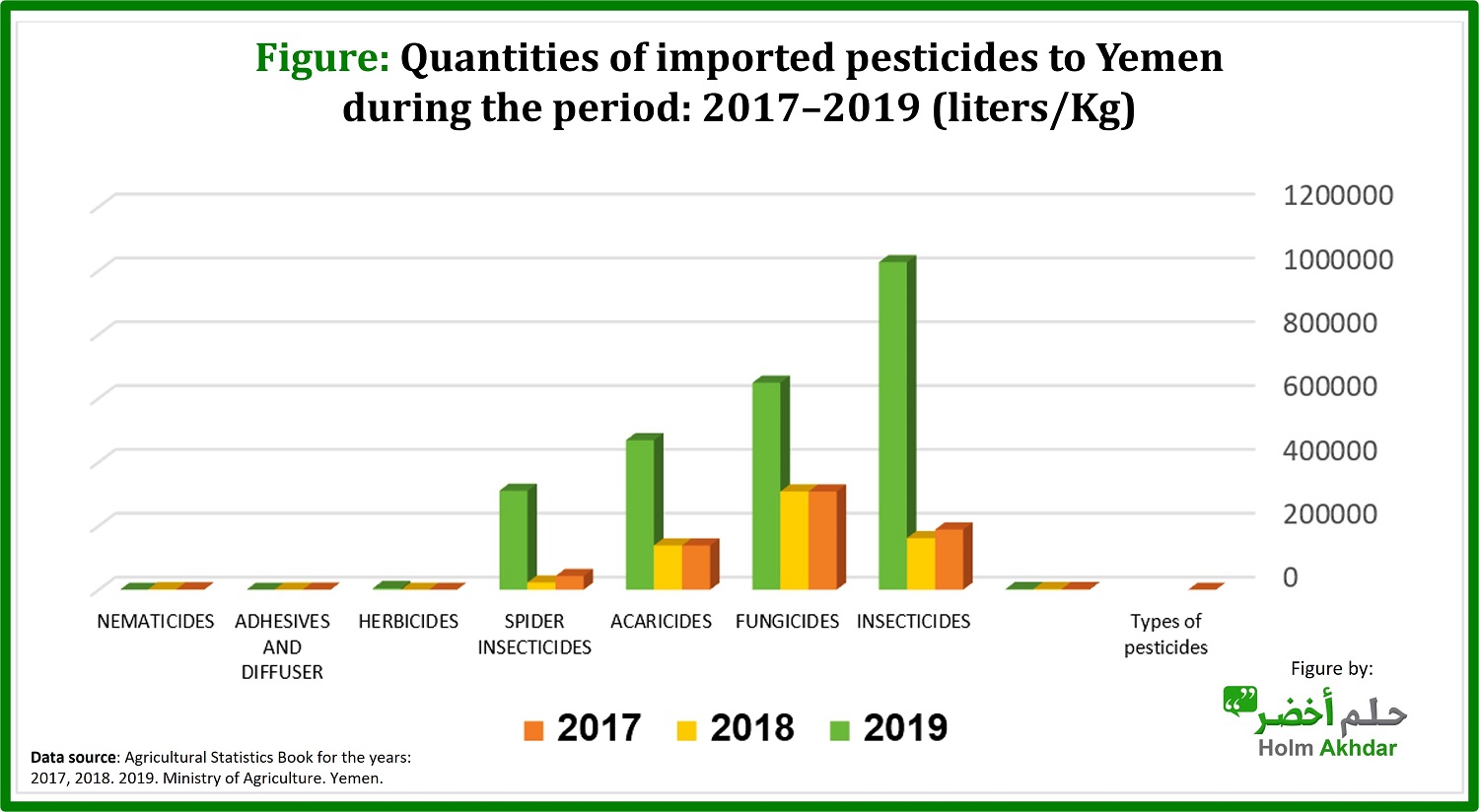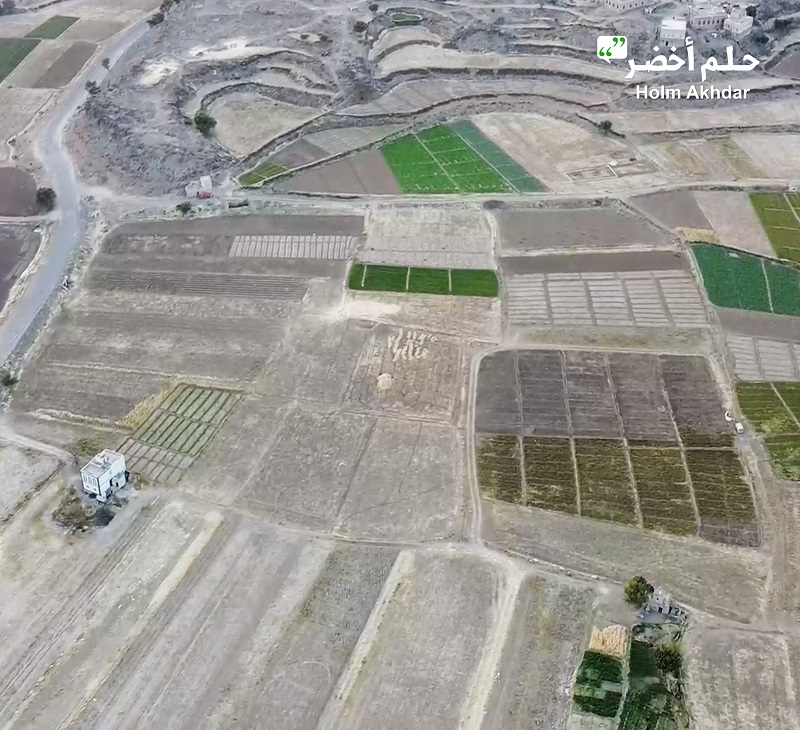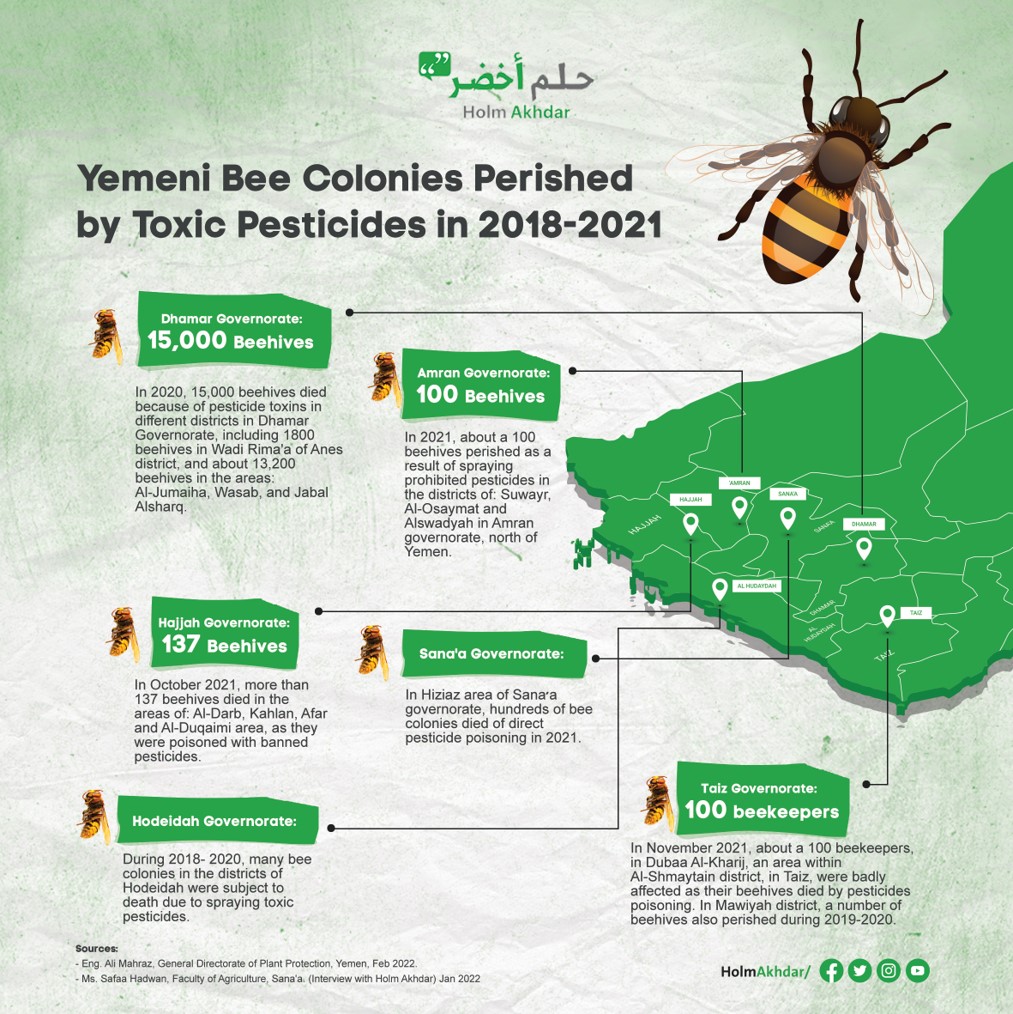By: Holm Akhdar Team
The increased indiscriminate use of pesticides have aggravated the threats to Yemeni bee colonies that pollinate wild plants and food crops.
In the fertile agricultural governorates, north and south of Yemen, toxic pesticides affected the soil, water, and food crops production.
Insecticides negatively affect the pollination processes of wild plants, and natural pest control, both of which are key components of ecosystems.
In this part of the Special Reporting series, Holm Akhdar addresses the environmental impacts of pesticides in Yemen, focusing on the Yemeni bee breed.

Pesticides Threaten the Environment
Chemical insecticides are of the environmental pollutants, as they are used to control insects, including those in the qat trees, as well as disease-borne insects.
Although some pesticides and fertilizers provide some kind of benefit in regions of the world, it is quite different for Yemen.
In Yemen, pesticides also cause the annihilation of beneficial insects, natural pollinators, such as bees and butterflies, and affect birds, sparrows and others. (Haidara, 2002).
Locally, the pesticides are used randomly and intensively, as about 70% of the country’s pesticides are used for purposes other than pest control.
Meanwhile, banned and smuggled varieties of pesticides are being traded in the country as a result of ignorance and poor pesticide control. This increases the adverse health and environmental impacts.
Pesticides and fertilizers of dangerous types have destroyed soil fertility and caused the degradation of many agrarian lands in Yemen.
Speaking to Holm Akhdar, Dr. Adnan Al-Sanwi, Vice Dean of the Faculty of Agriculture – Sana’a University said: “Importing globally banned pesticides has negative impacts on the agricultural sector and the environment as well.
“In my village, we used to have large bee production, as there were more than 20 beekeepers. However, after using these pesticides, no beekeepers are left in our village anymore”, added Dr. Al-Sanwi.

Yemeni Bees and Risks of Pesticides
Beekeeping and honey production are very old crafts that Yemen has known since ancient times. Yemeni beekeeping dates back to the 10th century BC (Khanbash, 2004).
The Yemeni bee breed is one of the smallest honeybee breeds that live pure in mountains and valleys. It is the only breed of global honeybee. (Khanbash, 2019)
The Yemeni bee breed has many morphological traits, as it is highly adaptable to prevailing environmental conditions. It is also characterized by frequent reproduction and migration. (Khanbash, 2019)
The environmental importance of Yemeni bees is featured in its being an active element in biodiversity prosperity and the increase in agricultural production.
Bees are directly affected by pesticides that lead to their immediate death, or by transferring nectar and pollen contaminated by pesticide to the beehive, which results in the death of the brood, and sometimes the queen. Also, honey is likely to get contaminated. (Haidara, 2002)

15,000 Beehives Killed by Pesticides
Beekeeping in Yemen depends mainly on the beekeepers’ frequent moves in search of pasture for 7-8 times a year. This makes their crops highly vulnerable to environmental and climatic factors.
According to an article, most beekeepers in Yemen adopt traditional methods and do not use any chemicals to control pests and diseases affecting their beehives.
The heavy use of banned pesticides and fertilizers by farmers during the past years had triggered serious risk to Yemeni bee colonies.
More than 7,000 tons of pesticides are imported annually in Yemen, 70% of which is used on the qat tree
During 2018-2021, the General Directorate of Plant Protection at the Ministry of Agriculture recorded tens of thousands of beehives in 6 governorates, died of pesticide poisoning.
Safaa Hadwan, a researcher and a teaching assistant at the Faculty of Agriculture, Sana’a University, believes that the most prominent impact of pesticides on bees is the poisoning and death of beehives.
In 2020, 15,000 beehives were killed as a result of spraying banned pesticides in different areas of Dhamar Governorate, in the middle of the country, including 1,800 beehives died in Wadi Rama’a of Anes district, and about 13,200 hives died in the areas: Al-Jumaiha, Wasab, Jabal Al-Sharq, and others.
“Two years ago, tens of thousands of Yemeni beehives were poisoned in the districts of Dhamar Governorate and other areas. Nearly 15,000 hives perished due to the indiscriminate spray of highly toxic and banned pesticides”, confirmed Safaa Hadwan.
In July, 2021, about 100 beehives died as a result of spraying banned pesticides in the districts of: Suwayr, Al-Osaymat and Alswadyah in Amran governorate, north of Yemen.
In October 2021, more than 137 beehives died by pesticides in the areas of: Al-Darb, Kahlan, Affar and Al-Duqaimi area, in Hajjah governorate.
In November 2021, about 100 beekeepers, in Dubaa Al-Kharij, an area within Al-Shmaytain district, in Taiz, were badly affected as their beehives died by pesticides poisoning. In Mawiyah district, hundreds of beehives also perished during 2019-2020.
“Over the years: 2018-2020, many bee colonies in Tehama districts in Hodeidah governorate were poisoned and killed by pesticide spraying in pepper fields,” said Eng. Ali Mahrez, Director of Campaigns – Plant Protection General Directorate.
“In 2021, hundreds of bee colonies died of direct pesticide poisoning In Hiziaz area of Sana’a governorate”. Added Eng. Ali Mahrez.

Increased Amounts of Imported Pesticides
Data from the General Directorate of Plant Protection at the Yemeni Ministry of Agriculture indicated that the quantities of imported pesticides in 2018 amounted to about 632,039 tons/liter.
As shown in Table (1), statistics by General Directorate of Plant Protection indicate that the quantity of imported pesticides in 2019 amounted to about 2,459,019 kg / liters.
This means that the increase in the imported pesticides in 2019 amounted to 1,862,980 liters/kg compared to 2018. It has doubled nearly 3 times, at an approximate rate of 294%.
According to the 2019 Agricultural Statistics Book, issued by the Ministry of Agriculture in Sana’a, the amounts of imported agricultural fertilizers (solid and liquid) amounted to about 1,335,029 tons / liter.
Meanwhile, the amounts of agricultural fertilizers (solid and liquid) imported to Yemen during 2018, reached about 529,879 tons/liter, which reflects a twofold increase in imports.
During the past two years, the import of pesticides has increased, Eng. Ali Mahrez, Director of Campaigns – Plant Protection Directorate, confirms: “More than 7,000 tons of pesticides are imported annually, 70% of which is used on the qat tree. It is one of the biggest problems for farmers, as they use pesticides not for pest control, but for other purposes like the qat activation, improvement and coloring.”

Damage Sustained by Yemeni Honey
The indiscriminate use of pesticides has damaged many agricultural lands and exacerbated the risks to the bee breed and the production of the Yemeni honey, one of the country’s most valuable commodities.
Yemeni honey is produced in 21 Yemeni governorates. The largest honey-producing governorates are: Hadramout, Shabwa, Abyan, Hodeidah, Amran, Hajjah and Mahweet.
Based on data by The Plant Protection General Directorate, the use of pesticides has increased in those governorates leading to a decline in the production of Yemeni honey, which is considered of the finest honey in the world.
Spraying of pesticides and toxins affects beehives and honey itself. Explaining to Holm Akhdar, Researcher Safaa Hadwan, said, “Farmers may spray pesticides at times of flowering, and bees feed on nectar and pollen.”
“This contaminated pollen or nectar may be fed to the brood in the hive and then be transferred into the honey. Yet, what incurred the most damage is the beehive itself”, said Safa’a.
In the same regard, Tawfiq Al-Mamari, a honey dealer in Sana’a, said: “When examining honey remnants at the laboratory of the Plant Protection Directorate at the Ministry of Agriculture, in order to export honey to some countries as required, we sometimes find that pesticide residues can still be traced in the honey coming from certain honey-producing areas in Yemen.”

Decline of Yemeni Honey Production
Data by the Directorate of Agricultural Statistics indicate that Yemeni honey production had declined in the past years, from 5 thousand tons in 2004 to about 2,823 tons in 2020.
According to data by the Animal Production Department at the Ministry of Agriculture, the number of Yemeni beehives totaled 1,291 million in 2020, compared to 1,322 million hives before the war.
“Some beekeepers in Hajjah, Mahweet and Amran lost their entire production, and some lost 300-400 hives because of the toxic pesticides.” said Al-Mamari, a honey dealer.
It is estimated that, Yemeni honey trade amounts to about $500 million a year, with more than 90,000 beekeepers work in Yemen.
In 2016, Yemen’s honey production sector had reportedly incurred heavy losses, estimated at more than $200 million, due to the conflict.
According to a 2020 UNDP report on Yemeni honey production, the non-seasonal rains caused by climate change during flowering seasons threatened the livelihoods of more than 100,000 households in Yemen.

Pesticides and Land Degradation
The agricultural sector is the main source of employment in Yemen. Today, however, it is endangered by risks of continued land degradation caused by banned pesticides.
Smuggled and banned pesticides have affected the agricultural sector, which is considered one of the key non-oil sectors of the Yemeni economy.
The vital role of the agricultural sector is focused on supporting food security and combating poverty. It provides about 25% of the country’s food consumption.
Shocks and losses sustained by the agricultural sector have exacerbated by the war, climate, and fuel crisis, besides many other factors, most notably, the increased use of toxic pesticides.
Pesticides and fertilizers destroyed the soil fertility and caused the degradation of many agricultural lands.
Data by agricultural statistics show that the various crop areas, which ceased production in the past 10 years, amounted to about 344,642,000 hectares of cultivated land.
In an exclusive interview, Eng. Ali Mahrez told Holm Akhdar, “About 136,000 hectares in Yemen have become degraded lands due to excessive use of pesticides on the qat tree. For example, in Mawiyah (Taiz), all lands are affected by salinization, in addition to areas in Arhab district and many areas in Anes- Dhamar governorate, all these lands are used for qat growing.”
In the same context, Prof. Abdull-Rahman Thabet, the Professor of Pesticide Toxicology at Sana’a University, confirms: “Banned pesticides, according to recent field studies (3 years ago), reached 105 active substances, and these active substances contain more than 450 trade names. The use of these substances is still prohibited worldwide”.
Proposed Interventions and Solutions
The environmental threats triggered by pesticides that destroy bees and other pollinators, require a national plan focused on saving the Yemeni bee breed as a key component of biodiversity.
Yemen needs to put in force agricultural extension policies, restore the role of agricultural research for crop development, and curb the deterioration caused by pesticides in the soil and agricultural production.
In addition, stricter legislation to control pesticides must be imposed, which contributes to reducing risks threatening the agricultural and livestock production in the country.
Prioritizing the development, import and access of pesticides and low-risk bio-protectants.
Indeed, to ensure a chemicals-safe future with minimal adverse effects of pesticides and fertilizers, progressive and transformative actions are required to address the root causes and shift market demand, accompanied by supportive enabling measures.
Furthermore, as a priority transformative measure, crop management should be changed, and ecosystem-based approaches should be adopted.
In addition, the trade in illegal below-standard counterfeit pesticides has to be confronted, and a full support to be granted for expanding product liability by all pesticide dealers and importers in Yemen.

List of references:
– Khanbash, M. Saeed, “The Varroa jacobsoni and the Yemeni Bee”, Honeybee Research Center, Hadhramout University of Science and Technology. Yemen, June 2004.
– Khanbash, M. Saeed, “Studies on Yemeni Bees”, Arab Scientific Society Organization, Qatar, May 2019.
– Haidara, Midhlah, “Insecticides and their role to environmental pollution in Yemen”, Assiut Journal of Environmental Studies, Egypt, Issue (23), July, 2002.
– “Yemeni Honeybee Breed: What Makes It Unique”, Holm Akhdar Report, Feb, 2020.
– Agricultural Statistics Book for the years: 2019/ 2018, Ministry of Agriculture and Irrigation, Sana’a, Republic of Yemen.
– “Pesticides and fertilizers and methods to minimize them,” Brief for Policy Makers, UNEP, 2022.

